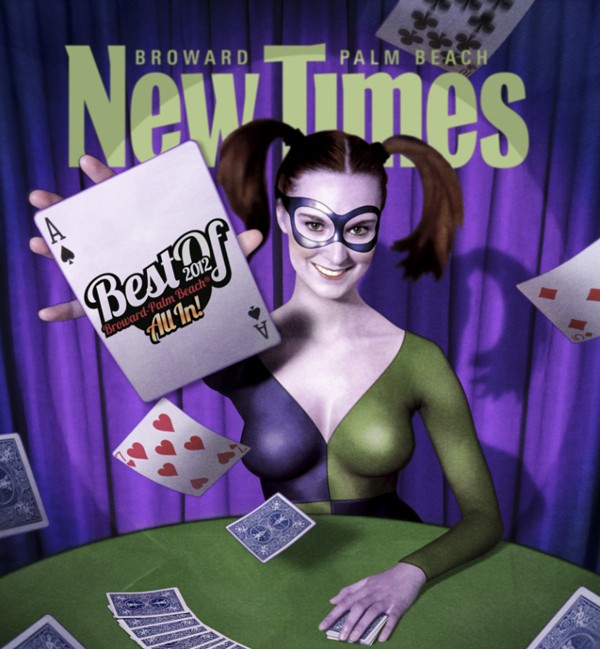They really need to make a movie about Vincent Nostokovich, AKA Trapper Nelson. According to legend, he grew up trapping muskrats in New Jersey during the industrial revolution. He ran away from home to Mexico but was arrested by Federales for gunrunning. So he headed back East with ten cents to his name, grew that into a living wage by gambling, and landed in South Florida. With a loan, he bought vast swaths of land — 800 acres eventually — where he trapped animals and sold their fur and meat. Weird rumors about him abounded — he could eat 18 eggs for breakfast, he dined on raw 'possum — but his reputation soared when he turned his land into a tourist stop and zoo and began wrestling alligators. Next thing, the six-foot-four beefcake was nicknamed "Tarzan of the Loxahatchee River" and started dating beautiful heiresses. He married but was drafted for World War II. Upon his return, he found his wife cheating and his tax bills piling up. He went cuckoo, chasing visitors from his land and becoming a recluse. Nelson was found dead in 1968 with a gunshot wound to his stomach. Was it suicide, as authorities ruled, or was he murdered? Conspiracy theorists have noted that men wanted his girlfriends, thieves wanted his treasure (rangers in 1984 found coins stashed in his chimney), and the government wanted his land — which it eventually got and made part of Jonathan Dickinson State Park. You're not supposed to camp here, but tour boats and canoes make pit stops. If you visit, see if the trapper's ghost will tell you the truth — locals have reported multiple sightings.
Best Place to Get Shipwrecked
Trapper Nelson's at Jonathan Dickinson State Park

- 16450 Southeast Federal Highway, Hobe Sound, 33455 Map
- 772-546-2771
- www.floridastateparks.org/jonathandickinson/default.cfm
Best Relic of a Bygone Era
Fort Jefferson

Before drone strikes and cyberattacks, long-range missiles and nuclear annihilation, wars were fought with cannonballs and other solid orbs of destruction. That mode of attack might help explain why more than 16 million bricks were used to build Fort Jefferson and it has still never been completed. Construction of the "Guardian of the Gulf of Mexico" began in 1846; officials called it off in 1875 due to concerns that the sheer weight of all those bricks was too stressful for the tiny island and its water system, according to the National Park Service. Located about 70 miles west of Key West in Dry Tortugas National Park, the imposing structure is little more than a subtropical ghost town these days. More than 160 years of storms and salty sea winds have taken their toll, but if you can get out to the small remote islands, you'll stroll around a one-of-a-kind artifact that would never be deemed feasible in these modern times.
- 70 miles west of Key W., Key West, 33040 Map
- www.nps.gov/drto
Best New Park
Snook Islands Natural Area
Once in a blue moon, our elected officials decide to restore a natural habitat instead of bulldozing it for development. In 2005, Palm Beach County created the Snook Islands by filling holes in the Lake Worth Lagoon with dredged sand imported from Peanut Island. Volunteers planted red mangroves on the barren landscape, and today the islands are full of scampering crabs and leggy birds. In February, the county created a new way to enjoy the islands near the western end of the Lake Worth Bridge. There's a small, grassy park overlooking the water, along with a fishing pier, dock, and boat launch area. The highlight is a 545-foot-long wooden-plank boardwalk winding past the mangrove trees into the lagoon. Visitors can walk over the water, listening to the gentle lapping of waves, as birds skim the water and soar above the trees. It's a true oasis in the city.
Best Flack
Det. Travis Mandell
Despite being tasked specifically with dealing with the public, many spokespeople seem to pretty much hate dealing with pesky reporters. Unlike other public relations professionals who are either unbearable cranks or dissembling sugarcoaters, Mandell tells it like it is in reference to investigations and public records. He sometimes even — gasp — engages in friendly chit-chat. He's a straight shooter of the metaphorical kind.
Best Dolphins Player
David Garrard
It's easy to see why David Garrard is the best Dolphin — he's been practicing way longer than everyone else. When Garrard played his first game for the Jaguars in 2002, Dolphins center Mike Pouncey was 13 — that's what we in the biz call "a big head start." He's thrown for 89 touchdowns in ten seasons, which means, if he keeps it up, he's on pace to pass Dan Marino for career touchdowns in the 2048 season. He'll only be 70 years old!
Best Marlins Player
Giancarlo Stanton
Even the Outfielder Formerly Known as Mike Stanton is getting in on the rebranding craze — though his dad calls him "Mike" and his mom calls him "Cruz," Stanton said during spring training that he was more comfortable going by his real first name, "Giancarlo." With 34 home runs last year and a .893 OPS, one can't help but agree with catcher John Buck: "When I think of 'Giancarlo,' I think of someone with long, flowing hair like Fabio. But if he keeps hitting homers, I'll call him whatever he wants me to call him."
Best Panthers Player
Brian Campbell
The Panthers picked up this 32-year-old Canadian last year, and it's paid off big time — in addition to four three-assist games, he had a four-assist game last October and now sits comfortably near the top in the league for feeding goals up to the offense. Plus, who can resist those glimmering white teeth?
Best Miami Heat Player
Udonis Haslem
Broadcasters love when Udonis Haslem comes off the bench because it gives them an excuse to use terms like "hustle," "heart," and "power player." The real upside of Haslem checking in is the chance of catching a glimpse of the tremendous, retina-scorching tattoo of Florida carved across the big man's back. Yes, he has an outline of the entire state tattooed on him, and it's not what one might call geographically proportionate. From a purely statistical view, Haslem's six points and seven rebounds per game halfway through the season don't even get him close to being the best at anything on the floor. And that's why we love him. The Miami native reps Florida hard, and you have to root for a hometown hero whose résumé includes balling in Gainesville. Anyway, LeBron and D-Wade have already won this thing, and did you really think this coveted accolade would go to that Harry Potter-loving Texan, Bosh?
Best Jai Alai Player
Aitzol "Olate" Larruskain, Number 42

"OLLAAAAAAATTEEEEEEE!" That's what you should scream when you're sitting in the nearly deserted spectator area at Dania Jai Alai, watching players in brightly colored suits scoop up a goatskin ball and hurl it against the wall at breakneck speed. At least, that's what we screamed every time we saw this unassuming 38-year-old from Basque country — the birthplace of this perplexing sport — scuttle to the front of the court and deliver a devastating serve return that sent the ball bouncing low against the wall, falling out of play before an opposing team member could catch it. If you have no idea what we're talking about, that's OK. We don't really either. Just go watch a game — it's free, you can drink cheap beer, and thanks to us, you'll be one of the few people in the seats hurling praise instead of insults.
- 301 E. Dania Beach Blvd., Dania, 33004 Map
- 954-927-2841
- www.dania-jai-alai.com
Best Place to Gamble
Dania Jai-Alai

If this place has fallen so far and is still so much fun, it must have been unbearably awesome in its heyday. Once you pick up the rules of the game (if you've ever played wall ball, you'll get it in no time), the jai-alai palace will give you hours of (frustrating) enjoyment in a low-pressure environment with cheap beers, cheap bets, and none of the ridiculous crowds of some of the more popular South Florida gambling halls. Be prepared, though — you're never madder about losing a dollar than when some schmuck named Manex loafs an easy catch at the end of the night.
- 301 E. Dania Beach Blvd., Dania, 33004 Map
- 954-927-2841
- www.dania-jai-alai.com





